2009 Seat Ibiza ST service indicator
[x] Cancel search: service indicatorPage 29 of 250
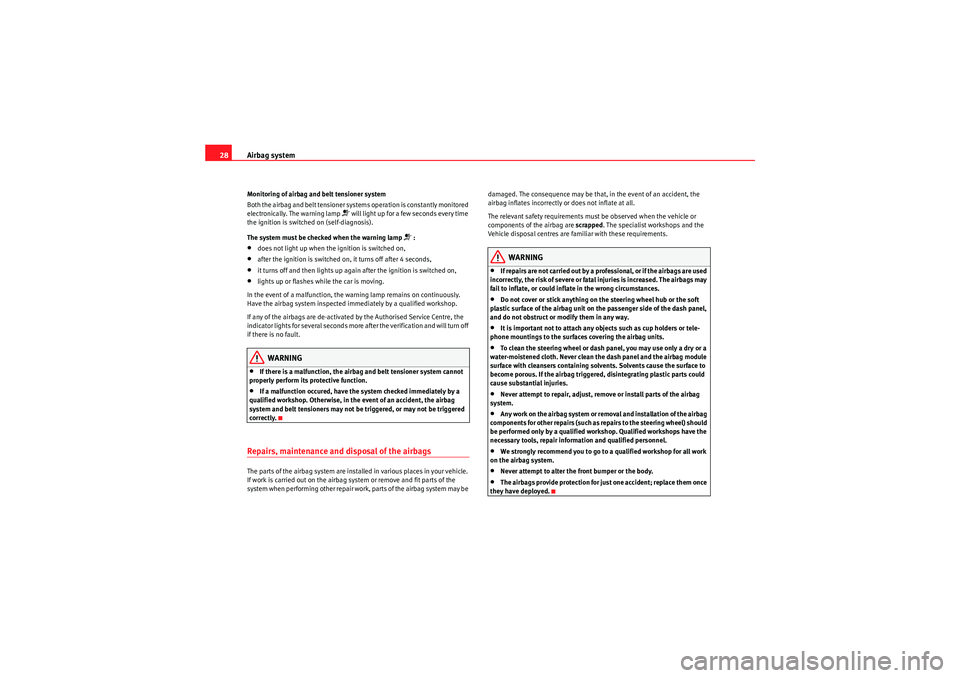
Airbag system
28Monitoring of airbag and belt tensioner system
Both the airbag and belt tensioner systems operation is constantly monitored
electronically. The warning lamp
will light up for a few seconds every time
the ignition is switched on (self-diagnosis).
The system must be checked when the warning lamp
:
•does not light up when the ignition is switched on,•after the ignition is switched on, it turns off after 4 seconds,•it turns off and then lights up again after the ignition is switched on,•lights up or flashes while the car is moving.
In the event of a malfunction, the warning lamp remains on continuously.
Have the airbag system inspected immediately by a qualified workshop.
If any of the airbags are de-activated by the Authorised Service Centre, the
indicator lights for several seconds more after the verification and will turn off
if there is no fault.WARNING
•If there is a malfunction, the airbag and belt tensioner system cannot
properly perform its protective function.•If a malfunction occured, have the system checked immediately by a
qualified workshop. Otherwise, in th e event of an accident, the airbag
system and belt tensioners may not be triggered, or may not be triggered
correctly.
Repairs, maintenance and disposal of the airbagsThe parts of the airbag system are installed in various places in your vehicle.
If work is carried out on the airbag system or remove and fit parts of the
system when performing other repair work, parts of the airbag system may be damaged. The consequence may be that, in the event of an accident, the
airbag inflates incorrectly or does not inflate at all.
The relevant safety requirements must be observed when the vehicle or
components of the airbag are
scrapped. The specialist workshops and the
Vehicle disposal centres are familiar with these requirements.
WARNING
•If repairs are not carried out by a professional, or if the airbags are used
incorrectl y, the ris k of severe or fatal inju ries is increase d. T he airbags may
fail to inflate, or could inflate in the wrong circumstances.•Do not cover or stick anything on the steering wheel hub or the soft
plastic surface of the airbag unit on the passenger side of the dash panel,
and do not obstruct or modify them in any way.•It is important not to attach any objects such as cup holders or tele-
phone mountings to the surfaces covering the airbag units.•To clean the steering wheel or dash panel, you may use only a dry or a
water-moistened cloth. Never clean the dash panel and the airbag module
surface with cleansers containing solvents. Solvents cause the surface to
become porous. If the airbag triggered, disintegrating plastic parts could
cause substantial injuries.•Never attempt to repair, adjust, remove or install parts of the airbag
system.•Any work on the airbag system or removal and installation of the airbag
components for other repairs (such as repairs to the steering wheel) should
be performed only by a qualified wo rkshop. Qualified workshops have the
necessary tools, repair inform ation and qualified personnel.•We strongly recommend you to go to a qualified workshop for all work
on the airbag system.•Never attempt to alter the front bumper or the body.•The airbags provide protection for just one accident; replace them once
they have deployed.
Ibiza ST_EN.book Seite 28 Dienstag, 12. Januar 2010 4:03 16
Page 51 of 250

Cockpit
50Rev counter
The rev counter displays the engine speed in revolutions per
minute.The start of the red zone ⇒ page 49, fig. 28 indicates the maximum
engine speed operating at service temperature. However, it is advisable to
change up a into a higher gear, move the selector lever to D or lift your foot
off the accelerator before the needle reaches the red zone.
Caution
The rev counter needle must never enter the red zone on the scale. Risk of
engine damage.
For the sake of the environment
Changing up into higher gears early will help you to save fuel and minimise
engine noise.SpeedometerThe speedometer is equipped with a digital odometer and a trip recorder, in
addition to a service intervals display.
During the running-in period, the instructions shown on ⇒page 156 should
be followed.
Digital instrument panel displayFuel gauge
and reserve indicator
Instrument panel: fuel gauge
The fuel tank has a capacity of approx. 45 litres.
When the needle reaches the reserve zone ⇒fig. 29 , the warning lamp will
light and an acoustic signal will sound reminding the driver to refuel. At this
point there are still about 7 litres of fuel in the tank.Digital clock* – To set the hour, press button ⇒page 49, fig. 28 . The “hour”
option flashes on the digital display and is set using button
“set” ⇒page 49, fig. 28 .
A1
Fig. 29 Fuel gauge
A4
A5
Ibiza ST_EN.book Seite 50 Dienstag, 12. Januar 2010 4:03 16
Page 59 of 250
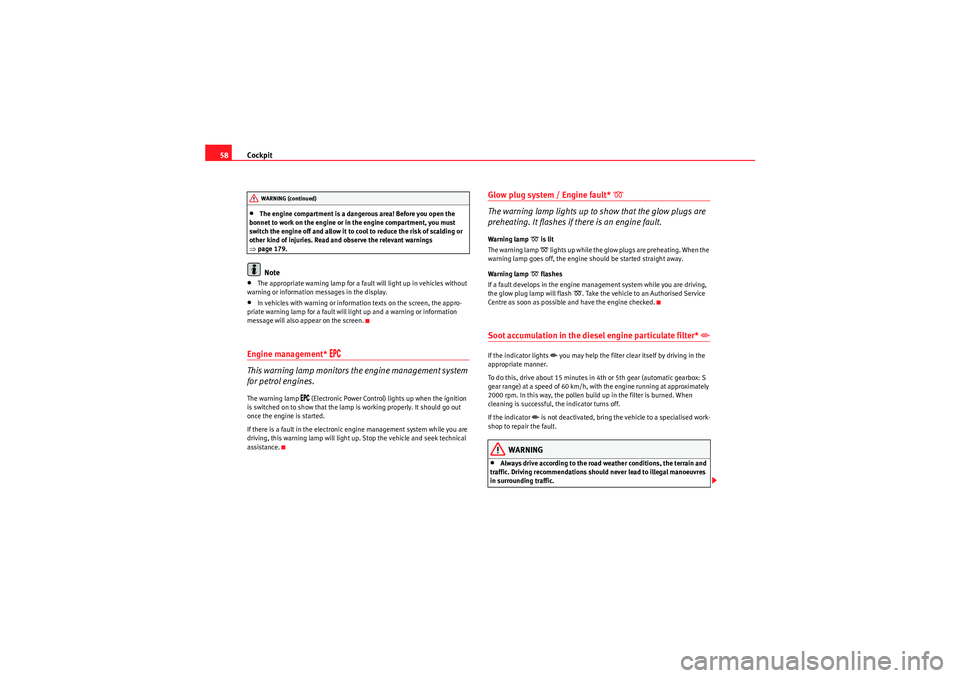
Cockpit
58•The engine compartment is a dangerous area! Before you open the
bonnet to work on the engine or in the engine compartment, you must
switch the engine off and allow it to cool to reduce the risk of scalding or
other kind of injuries. Read and observe the relevant warnings
⇒ page 179.Note
•The appropriate warning lamp for a fault will light up in vehicles without
warning or information messages in the display.•In vehicles with warning or information texts on the screen, the appro-
priate warning lamp for a fault will light up and a warning or information
message will also appear on the screen.Engine management*
This warning lamp monitors the engine management system
for petrol engines.
The warning lamp
(Electronic Power Control) lights up when the ignition
is switched on to show that the lamp is working properly. It should go out
once the engine is started.
If there is a fault in the electronic engine management system while you are
driving, this warning lamp will light up. Stop the vehicle and seek technical
assistance.
Glow plug system / Engine fault*
The warning lamp lights up to show that the glow plugs are
preheating. It flashes if there is an engine fault.
Warning lamp
is lit
The warning lamp lights up while the glow plugs are preheating. When the
warning lamp goes off, the engine should be started straight away.
Warning lamp
flashes
If a fault develops in the engine management system while you are driving,
the glow plug lamp will flash
. Take the vehicle to an Authorised Service
Centre as soon as possible and have the engine checked.
Soot accumulation in the diesel engine particulate filter*
If the indicator lights
you may help the filter clear itself by driving in the
appropriate manner.
To do this, drive about 15 minutes in 4th or 5th gear (automatic gearbox: S
gear range) at a speed of 60 km/h, with the engine running at approximately
2000 rpm. In this way, the pollen build up in the filter is burned. When
cleaning is successful, the indicator turns off.
If the indicator
is not deactivated, bring the vehicle to a specialised work-
shop to repair the fault.
WARNING
•Always drive according to the road weather conditions, the terrain and
traffic. Driving recommendations should never lead to illegal manoeuvres
in surrounding traffic.
WARNING (continued)
Ibiza ST_EN.book Seite 58 Dienstag, 12. Januar 2010 4:03 16
Page 65 of 250

Cockpit
64If the warning lamp lights up again after driving on for a short distance, stop
the vehicle and switch the engine off . Contact an Authorised Service Centre
or a qualified workshop.
Coolant level too low
If the warning light comes on, stop the vehicle, switch off the engine and wait
for it to cool down First check the coolant level. If the level of the coolant is
below the “MIN” mark, top up with coolant liquid ⇒.
WARNING
•If your vehicle is immobilised for any technical reasons, move it to a
safe distance from traffic. Tur n the e ngin e off, turn t he hazard l ights on and
place the warning triangle.•Never open the bonnet if you can see or hear steam or coolant escaping
from the engine compartment. Risk of scalding. Wait until you can no
longer see or hear escaping steam or coolant.•The engine compartment is a danger ous area! Before carrying out any
work in the engine compartment, switch off the engine and allow it to cool
down. Always note the corresponding warnings ⇒page 179.
Alternator
This warning lamp signals a fault in the alternator.
The warning lamp
lights up when the ignition is switched on. It should go
out when the engine has started running.
If the warning lamp lights up while driving, the alternator is no longer
charging the battery. You should immediately drive to the nearest qualified
workshop. You should avoid using electrical equipment that is not absolutely necessary
because this will drain the battery.
If the indicator flashes the voltage is insufficient for normal vehicle
operation.
Turn signals
The warning lamp flashes when the turn signals are in oper-
ation.Depending on which turn signal is operated, either the left
or right
turn
signal indicator lamp flashes. Both warning lamps will flash at the same time
when the hazard warning lights are switched on.
If any of both turn signals fails, the warning lamp will start flashing twice
faster than normal.
For further information on the turn signals, please see ⇒page 92.
Electronic immobiliser “Safe”*
This warning lamp flashes if an unauthorised key is used.Inside the key there is a chip that deactivates the electronic immobiliser auto-
matically when the key is inserted into the ignition. The immobiliser will be
activated again automatically as soon as you pull the key out of the ignition
lock.
Ibiza ST_EN.book Seite 64 Dienstag, 12. Januar 2010 4:03 16
Page 78 of 250
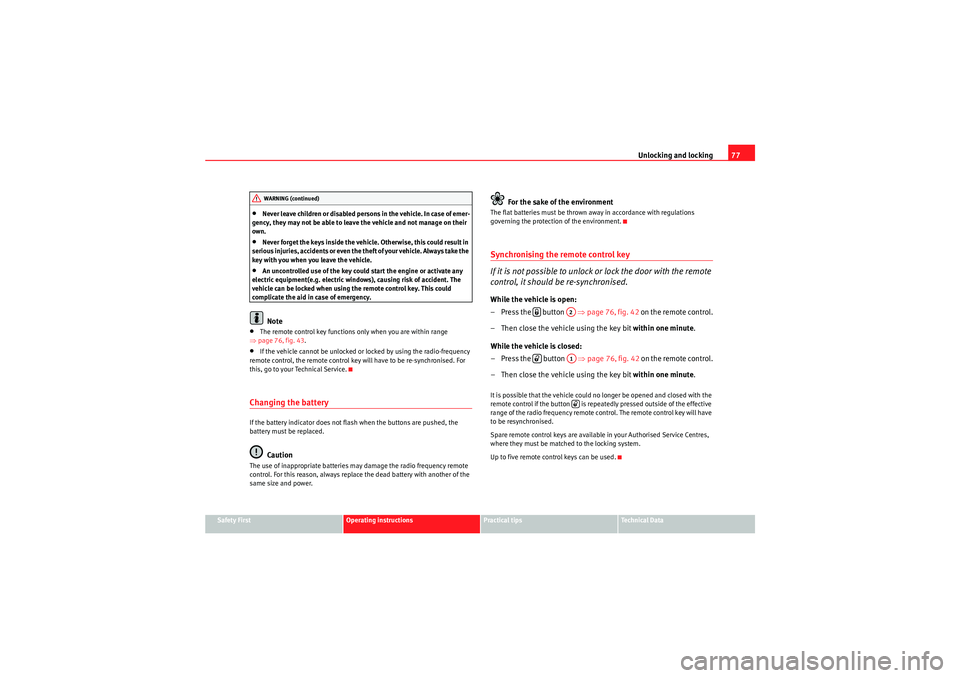
Unlocking and locking77
Safety First
Operating instructions
Practical tips
Technical Data
•Never leave children or disabled persons in the vehicle. In case of emer-
gency, they may not be able to leave the vehicle and not manage on their
own.•Never forget the keys inside the vehicle. Otherwise, this could result in
serious injuries, accidents or even the theft of your vehicle. Always take the
key with you when you leave the vehicle.•An uncontrolled use of the key could start the engine or activate any
electric equipment(e.g. electric windows), causing risk of accident. The
vehicle can be locked when using the remote control key. This could
complicate the aid in case of emergency.Note
•The remote control key functions only when you are within range
⇒ page 76, fig. 43.•If the vehicle cannot be unlocked or locked by using the radio-frequency
remote control, the remote control key will have to be re-synchronised. For
this, go to your Technical Service.Changing the batteryIf the battery indicator does not flash when the buttons are pushed, the
battery must be replaced.
Caution
The use of inappropriate batteries may damage the radio frequency remote
control. For this reason, always replace the dead battery with another of the
same size and power.
For the sake of the environment
The flat batteries must be thrown away in accordance with regulations
governing the protection of the environment.Synchronising the remote control key
If it is not possible to unlock or lock the door with the remote
control, it should be re-synchronised.While the vehicle is open:
– Press the button ⇒page 76, fig. 42 on the remote control.
– Then close the vehicle using the key bit within one minute.
While the vehicle is closed:
– Press the button ⇒page 76, fig. 42 on the remote control.
– Then close the vehicle using the key bit within one minute.It is possible that the vehicle could no longer be opened and closed with the
remote control if the button is repeatedly pressed outside of the effective
range of the radio frequency remote control. The remote control key will have
to be resynchronised.
Spare remote control keys are available in your Authorised Service Centres,
where they must be matched to the locking system.
Up to five remote control keys can be used.
WARNING (continued)
A2
A1
Ibiza ST_EN.book Seite 77 Dienstag, 12. Januar 2010 4:03 16
Page 197 of 250
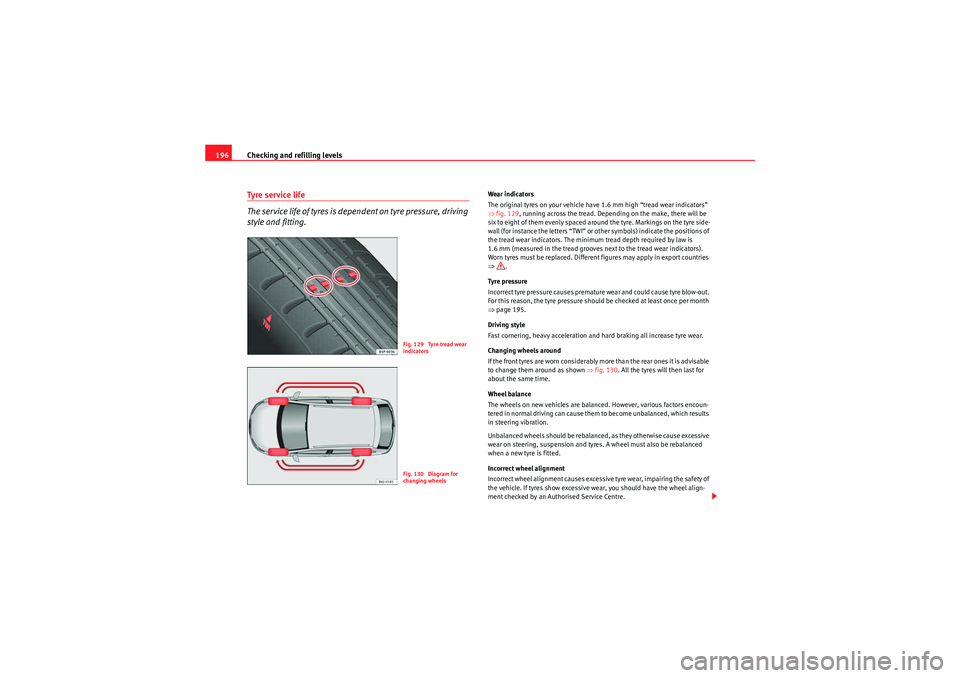
Checking and refilling levels
196Tyre ser vice life
The service life of tyres is dependent on tyre pressure, driving
style and fitting.
Wear indicators
The original tyres on your vehicle have 1.6 mm high “tread wear indicators”
⇒ fig. 129, running across the tread. Depending on the make, there will be
six to eight of them evenly spaced around the tyre. Markings on the tyre side-
wall (for instance the letters “TWI” or other symbols) indicate the positions of
the tread wear indicators. The minimum tread depth required by law is
1.6 mm (measured in the tread grooves next to the tread wear indicators).
Worn tyres must be replaced. Different figures may apply in export countries
⇒ .
Tyre pressure
Incorrect tyre pressure causes premature wear and could cause tyre blow-out.
For this reason, the tyre pressure should be checked at least once per month
⇒ page 195.
Driving style
Fast cornering, heavy acceleration and hard braking all increase tyre wear.
Changing wheels around
If the front tyres are worn considerably more than the rear ones it is advisable
to change them around as shown ⇒fig. 130 . All the tyres will then last for
about the same time.
Wheel balance
The wheels on new vehicles are balanced. However, various factors encoun-
tered in normal driving can cause them to become unbalanced, which results
in steering vibration.
Unbalanced wheels should be rebalanced, as they otherwise cause excessive
wear on steering, suspension and tyres. A wheel must also be rebalanced
when a new tyre is fitted.
Incorrect wheel alignment
Incorrect wheel alignment causes excessive tyre wear, impairing the safety of
the vehicle. If tyres show excessive wear, you should have the wheel align-
ment checked by an Authorised Service Centre.
Fig. 129 Tyre tread wear
indicatorsFig. 130 Diagram for
changing wheels
Ibiza ST_EN.book Seite 196 Dienstag, 12. Januar 2010 4:03 16
Page 198 of 250
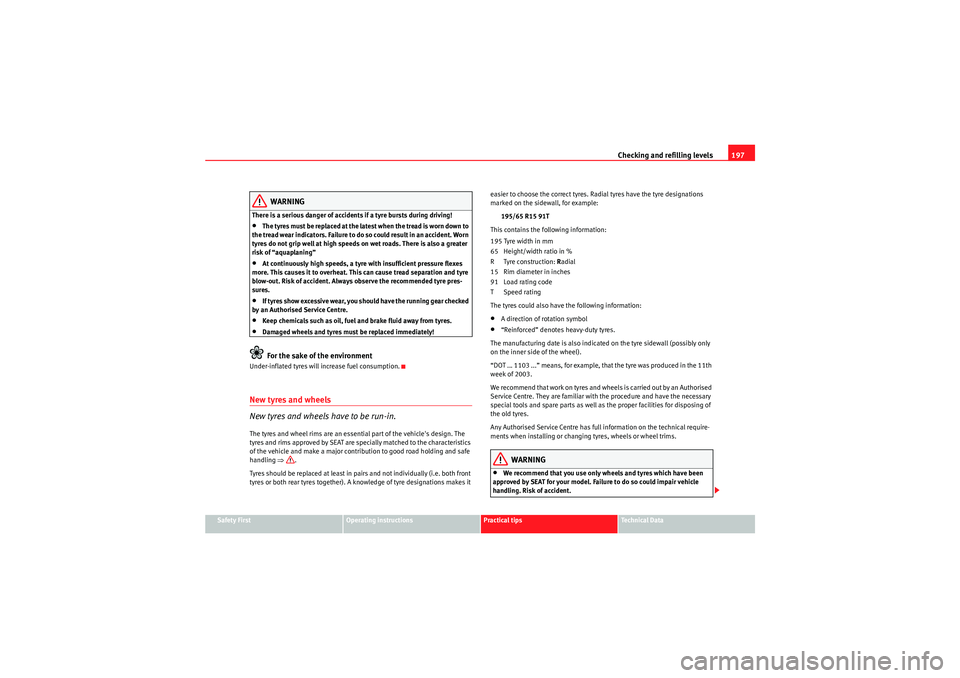
Checking and refilling levels197
Safety First
Operating instructions
Practical tips
Technical Data
WARNING
There is a serious danger of accidents if a tyre bursts during driving!•The tyres must be replaced at the latest when the tread is worn down to
the tread wear indicators. Failure to do so could result in an accident. Worn
tyres do not grip well at high speeds on wet roads. There is also a greater
risk of “aquaplaning” •At continuously high speeds, a tyre with insufficient pressure flexes
more. This causes it to overheat. This can cause tread separation and tyre
blow-out. Risk of accident. Always observe the recommended tyre pres-
sures.•If tyres show excessive wear, you should have the running gear checked
by an Authorised Service Centre.•Keep chemicals such as oil, fuel and brake fluid away from tyres.•Damaged wheels and tyres must be replaced immediately!For the sake of the environment
Under-inflated tyres will increase fuel consumption.New tyres and wheels
New tyres and wheels have to be run-in.The tyres and wheel rims are an essential part of the vehicle's design. The
tyres and rims approved by SEAT are specially matched to the characteristics
of the vehicle and make a major contribution to good road holding and safe
handling ⇒.
Tyres should be replaced at least in pairs and not individually (i.e. both front
tyres or both rear tyres together). A knowledge of tyre designations makes it easier to choose the correct tyres. Radial tyres have the tyre designations
marked on the sidewall, for example:
195/65 R15 91T
This contains the following information:
195 Tyre width in mm
65 Height/width ratio in %
RTyre construction: Radial
15 Rim diameter in inches
91 Load rating code
TSpeed rating
The tyres could also have the following information:
•A direction of rotation symbol•“Reinforced” denotes heavy-duty tyres.
The manufacturing date is also indicated on the tyre sidewall (possibly only
on the inner side of the wheel).
“DOT ... 1103 ...” means, for example, that the tyre was produced in the 11th
week of 2003.
We recommend that work on tyres and wheels is carried out by an Authorised
Service Centre. They are familiar with the procedure and have the necessary
special tools and spare parts as well as the proper facilities for disposing of
the old tyres.
Any Authorised Service Centre has full information on the technical require-
ments when installing or changing tyres, wheels or wheel trims.WARNING
•We recommend that you use only wheels and tyres which have been
approved by SEAT for your model. Failure to do so could impair vehicle
handling. Risk of accident.
Ibiza ST_EN.book Seite 197 Dienstag, 12. Januar 2010 4:03 16
Page 248 of 250

Index247
Soot accumulation in the diesel engine particulate
filter
warning lamp . . . . . . . . . . . . . . . . . . . . . . . . . 58
Spare parts . . . . . . . . . . . . . . . . . . . . . . . . . . . . . 172
Spare wheel . . . . . . . . . . . . . . . . . . . . . . . . . . . . 201
Speed selector lever lock warning lamp . . . . . . . . . . . . . . . . . . . . . . . . . 62
Speedometer . . . . . . . . . . . . . . . . . . . . . . . . . . . . 50
Starting Petrol engines . . . . . . . . . . . . . . . . . . . 134
Starting the engine . . . . . . . . . . . . . . . . . 133, 134 After the fuel tank has been run dry . . . . . . 134
Steam jets . . . . . . . . . . . . . . . . . . . . . . . . . . . . . 165
Steering . . . . . . . . . . . . . . . . . . . . . . . . . . . . . . . 130 Steering lock . . . . . . . . . . . . . . . . . . . . . . . . 132
Steering column controls Audio Control . . . . . . . . . . . . . . . . . . . . . . . . . 66
Steering wheel height adjustment . . . . . . . . . . 130
Storage compartment . . . . . . . . . . . . . . . . . . . . 118 Front passenger side . . . . . . . . . . . . . . . . . . 107
front seat . . . . . . . . . . . . . . . . . . . . . . . . . . . 109
Sun visor Sliding/tilting sunroof . . . . . . . . . . . . . . . . . . 85
Sun visors . . . . . . . . . . . . . . . . . . . . . . . . . . . . . . . 94
Switch Hazard warning lights . . . . . . . . . . . . . . . . . . 91
Heated rear window . . . . . . . . . . . . . . . . . . . . 90
Switches Electric windows . . . . . . . . . . . . . . . . . . . . . . 82
Sliding/tilting sunroof . . . . . . . . . . . . . . . . . . 85
Switching off the engine . . . . . . . . . . . . . . . . . . 134
TTank fuel level . . . . . . . . . . . . . . . . . . . . . . . . . . . . . 50
reserve indicator . . . . . . . . . . . . . . . . . . . . . . 50
tank capacity . . . . . . . . . . . . . . . . . . . . . . . . . 50
TCS . . . . . . . . . . . . . . . . . . . . . . . . . . . . . . . . . . . 152
TCS (Traction control system) warning lamp . . . . . . . . . . . . . . . . . . . . . . . . . 60
Technical modifications . . . . . . . . . . . . . . . . . . 172
The danger of not using the seat belt . . . . . . . . 19
Tightening torque of wheel bolts . . . . . . . . . . . 232
Tilting roof . . . . . . . . . . . . . . . . . . . . . . . . . . . . . . 85
Tools . . . . . . . . . . . . . . . . . . . . . . . . . . . . . . . . . . 201
Tow starting Comments . . . . . . . . . . . . . . . . . . . . . . . . . . 225
Towing . . . . . . . . . . . . . . . . . . . . . . . . . . . . . . . . 225
Towing a trailer . . . . . . . . . . . . . . . . . . . . 160, 232
Towing bracket . . . . . . . . . . . . . . . . . . . . . . . . . 161
Towing bracket, fitting . . . . . . . . . . . . . . . . . . . 174
Towing eye . . . . . . . . . . . . . . . . . . . . . . . . . . . . . 225
Tow-starting . . . . . . . . . . . . . . . . . . . . . . . . . . . . 225
Traction control system warning lamp . . . . . . . . . . . . . . . . . . . . . . . . . 60
Trailer eyes . . . . . . . . . . . . . . . . . . . . . . . . . . . . . 226
Trailer turn signals Warning lamp . . . . . . . . . . . . . . . . . . . . . . . . . 92
Trailer weights . . . . . . . . . . . . . . . . . . . . . . . . . . 232
Trips, checklist . . . . . . . . . . . . . . . . . . . . . . . . . . . . 8 Turn signals . . . . . . . . . . . . . . . . . . . . . . . . . . . . . 92
Warning lamp . . . . . . . . . . . . . . . . . . . . . 64, 92
Two-way radio . . . . . . . . . . . . . . . . . . . . . . . . . . 173
Type plate . . . . . . . . . . . . . . . . . . . . . . . . . . . . . . 230
Tyre Mobility-System (Tyre repair kit) . . . . . . . . 202
Tyre pressure . . . . . . . . . . . . . . . . . . . . . . . . . . . 195 warning lamp . . . . . . . . . . . . . . . . . . . . . . . . . 61
Tyre pressures . . . . . . . . . . . . . . . . . . . . . . . . . . 232
Tyre repair kit . . . . . . . . . . . . . . . . . . . . . . 202, 207
Tyre-Mobility-System (Tyre repair kit) . . . . . . . . 207
Tyres and wheels Dimensions . . . . . . . . . . . . . . . . . . . . . . . . . 197
Tyres service life . . . . . . . . . . . . . . . . . . . . . . . . 196
Tyres tread depth . . . . . . . . . . . . . . . . . . . . . . . . 196
Tyres with directional tread pattern . . . . . . . . . 195
UUnderbody protection . . . . . . . . . . . . . . . . . . . . 169VVehicle battery . . . . . . . . . . . . . . . . . . . . . . . . . . 192
Vehicle data . . . . . . . . . . . . . . . . . . . . . . . . . . . . 230
Vehicle identification data . . . . . . . . . . . . . . . . 230
Vehicle identification number . . . . . . . . . . . . . 230
Vehicle interior heating or cooling system . . . 124
Vehicle modifications . . . . . . . . . . . . . . . . . . . . 172
Vehicle paintwork Products for vehicle maintenance . . . . . . . 163
Waxing . . . . . . . . . . . . . . . . . . . . . . . . . . . . . 165
Ibiza ST_EN.book Seite 247 Dienstag, 12. Januar 2010 4:03 16